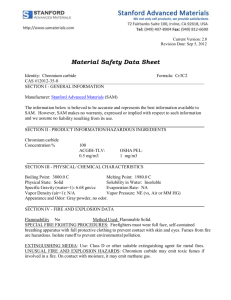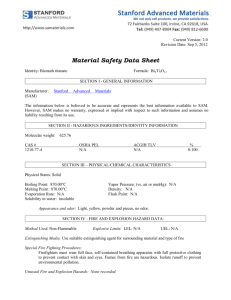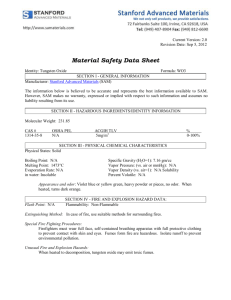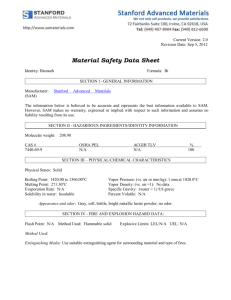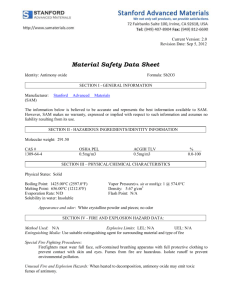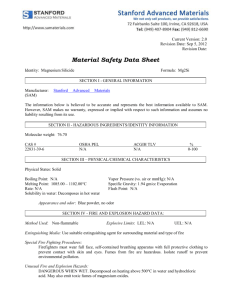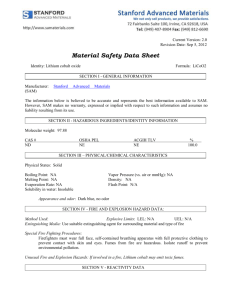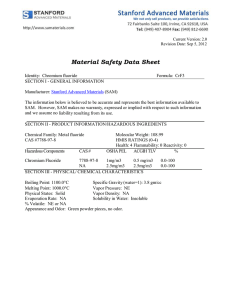Microsoft Word - Cr2O3 - Stanford Advanced Materials
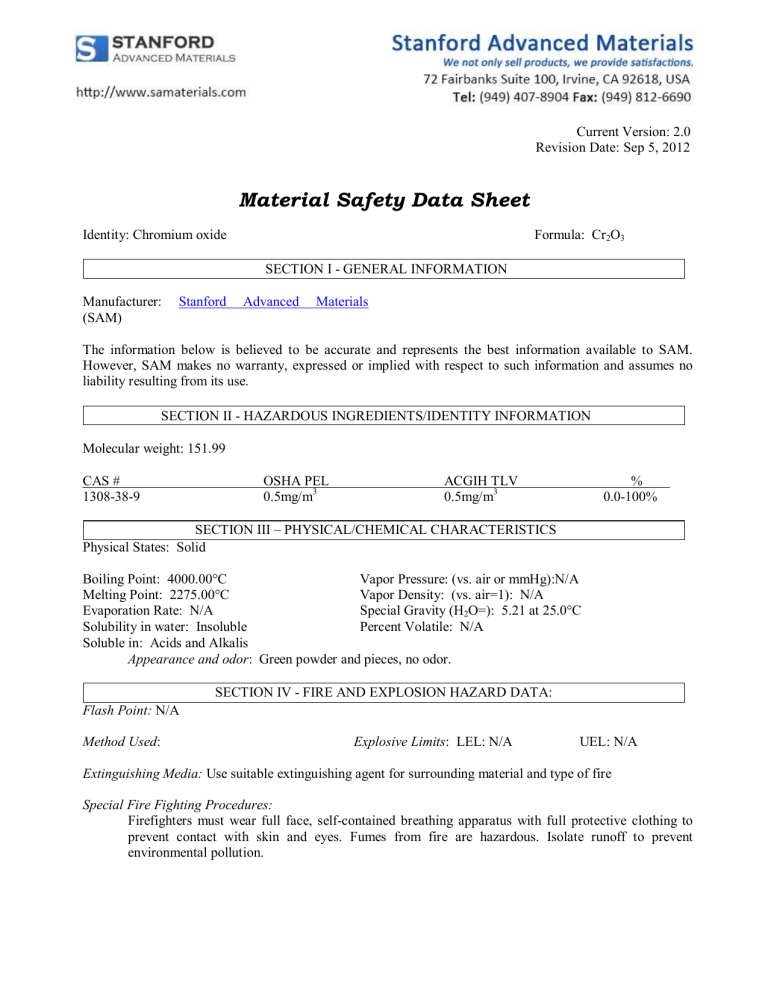
Current Version: 2.0
Revision Date: Sep 5, 2012
Material Safety Data Sheet
Identity: Chromium oxide Formula: Cr
2
O
3
SECTION I - GENERAL INFORMATION
Manufacturer: Stanford Advanced Materials
(SAM)
The information below is believed to be accurate and represents the best information available to SAM.
However, SAM makes no warranty, expressed or implied with respect to such information and assumes no liability resulting from its use.
SECTION II - HAZARDOUS INGREDIENTS/IDENTITY INFORMATION
Molecular weight: 151.99
CAS #
1308-38-9
OSHA PEL
0.5mg/m
3
ACGIH TLV
0.5mg/m
3
SECTION III – PHYSICAL/CHEMICAL CHARACTERISTICS
Physical States: Solid
Boiling Point: 4000.00°C
Melting Point: 2275.00°C
Evaporation Rate: N/A
Vapor Pressure: (vs. air or mmHg):N/A
Vapor Density: (vs. air=1): N/A
Special Gravity (H
2
O=): 5.21 at 25.0°C
Percent Volatile: N/A Solubility in water: Insoluble
Soluble in: Acids and Alkalis
Appearance and odor : Green powder and pieces, no odor.
Flash Point: N/A
SECTION IV - FIRE AND EXPLOSION HAZARD DATA:
Method Used : Explosive Limits : LEL: N/A
%
0.0-100%
UEL: N/A
Extinguishing Media: Use suitable extinguishing agent for surrounding material and type of fire
Special Fire Fighting Procedures:
Firefighters must wear full face, self-contained breathing apparatus with full protective clothing to prevent contact with skin and eyes. Fumes from fire are hazardous. Isolate runoff to prevent environmental pollution.
Unusual Fire and Explosion Hazards:
When heated to decomposition, it may give off toxic fumes of chromium oxide. Chromium oxide is a powerful oxidizer and may have a violent reaction with CIF
3
.
SECTION V - REACTIVITY DATA
Stability : Stable
Conditions to Avoid (stability) : None
Incompatibility: Strong oxidizing agents, acids and bases.
Hazardous Decomposition or Byproducts: Chromium oxide and oxygen
Hazardous Polymerization : Will not occur
Conditions to avoid (hazardous polymerization) : None
SECTION VI - HEALTH HAZARD DATA
Routes of entry : Inhalation? Yes Skin? Yes Eyes? Yes Ingestion? Yes Other? No
Signs and Symptoms of Overexposure:
Inhalation: May cause a red, dry throat, coughing and shortness of breath.
Ingestion: May cause nausea, diarrhea, and vomiting.
Skin : May cause redness, itching, inflammation and burning sensation.
Eye : May cause redness, itching, burning sensation and watering.
Health Hazards (Acute and Chronic):
Confirmed carcinogen with experimental tumorigenic data. Mutation dad reported. Chromate salts are suspected human carcinogens producing tumors of the lungs, nasal cavity, and paranasal sinus. Chronic acid and its salts have a corrosive action on the skin and mucous membranes. The lesions are confined to the exposed parts, affecting chiefly the skin and mucous membranes of the hands and forearms and the mucous membranes of the nasal septum. Hexavelent compounds are more toxic than the trivalent. (Sax, Dangerous
Properties of Industrial Materials, eight edition).
Inhalation:
Acute: Toxic by inhalation and is a severe irritant to the mucous membranes.
Chronic: May cause histological fibrosis of the lungs, nasal and/or lung cancer.
Ingestion:
Acute: Toxic by ingestion which may cause gastrointestinal disorders.
Chronic: No chronic health effects recorded.
Skin:
Acute: Severe skin irritant.
Chronic: May cause eczematous dermatitis,
Eye:
Acute: Severe eye irritant.
Chronic: No chronic health effects recorded.
Target Organs :
Carcinogenicity : NTP? Yes IARC Monographs? No OSHA Regulated? Yes
Medical Conditions Aggravated by Exposure :
Emergency and First Aid Procedures:
Inhalation: Remove victim to fresh air, keep warm and quiet, and give oxygen if breathing is difficult; seek medical attention
Ingestion:
Skin:
Eye:
Give 1-2 glasses of milk or water and induce vomiting, seek medical attention. Never induce vomiting or give anything by mouth to an unconscious person
Remove contaminated clothing, brush material off skin, wash affected area with mild soap and water, and seek medical attention if symptoms persist
Flush eyes with lukewarm water, lifting upper and lower eyelids for at least 15 minutes and seek medical attention
SECTION VII - PRECAUTIONS FOR SAFE HANDLING AND USE
Steps to be taken in case material is released or spilled:
Wear appropriate respiratory and protective equipment specified in section VIII. Isolate spill area, provide ventilation and extinguish sources of ignition. Vacuum up spill using a high efficiency particulate absolute (HEPA) air filter and place in a closed container for proper disposal. Take care not to raise dust.
Waste disposal method:
Dispose of in accordance with state, local, and federal regulations.
Hazard Label Information:
Store in cool, dry area and in tightly sealed container. Wash thoroughly after handling.
SECTION VIII - CONTROL MEASURES
Protective Equipment Summary (Hazard Label Information ):
NIOSH approved respirator, impervious gloves, safety glasses, clothes to prevent contact.
Ventilation:
Local Exhaust: May be necessary to control any air contaminations to within their PELs or TLVs during the use of this product. Use process enclosures, local exhaust ventilation, or other engineering controls to control airborne levels below recommended exposure.
Mechanical (General): Recommended.
Work/Hygienic/Maintenance Practices :
Implement engineering and work practice controls to reduce and maintain concentration of exposure at low levels. Use good housekeeping and sanitation practices. Do not use tobacco or food in work area.
Wash thoroughly before eating or smoking. Do not blow dust off clothing or skin with compressed air.
Please be advised that N/A can either mean Not Applicable or No Data Has Been Established

